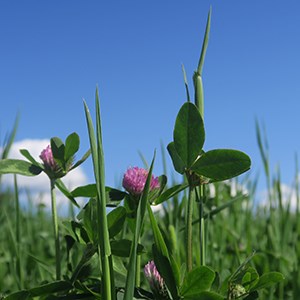We research how to grow high-yielding, resilient and nutrient-rich crops and forages in a sustainable manner in different climatic zones. This includes both annual and perennial species, as well as mixtures for various purposes including food, feed, and other uses.
Our ongoing research covers different aspects of forage production under Nordic conditions. Production, competitiveness, persistence and nutritive value is studied in mixed grass/legume swards. We employ various strategies for example, in relation to establishment, harvest, trampling, irrigation, or crop rotation. An example of our work involves late-season establishment of mixed grass-clover leys, where we explore different management practices and their effects on ley yields and clover performance.
Grain legumes and mixed maize – legume systems are in focus in our research in sub-Saharan Africa. Legumes are essential components of cropping systems and diets in many parts of the world. In our research, we study how to integrate and grow soybeans (a new crop in the region) in maize-based systems in southern Africa.
Ongoing projects
Forage production and management
- Establishment of leys in winter cereals in late season – SustAinimal, funded by Formas. Nilla Nilsdotter-Linde, Fatima El Khosht (PhD student), Ingrid Öborn, Ola Hallin (HS Sjuhärad). SustAinimal | Externwebben (slu.se)
- How will establishment of mixed ley in autumn-sown cereals affect red and white clover survival, performance and yield? Funded by Stiftelsen C.L. Behms fond för baljväxtodling. Fatima El Khosht, Nilla Nilsdotter-Linde, Ola Hallin (HS Sjuhärad), Ingrid Öborn.
- Influence of root rot on the sustainability of grass/legume leys – SustAinimal, funded by Formas. Nilla Nilsdotter-Linde, Ann-Charlotte Wallenhammar (HS). SustAinimal | Externwebben (slu.se)
- Influence of root rot on the sustainability of grass/legume leys, funded by Stiftelsen Lantbruksforskning (SLF). Nilla Nilsdotter-Linde, led by Ann-Charlotte Wallenhammar (HS).
Grain legume agronomy
- Leg4DEV – Legume-based agroecological intensification of maize and cassava cropping systems in Sub-Saharan Africa for water-food-energy nexus sustainability, nutritional security & livelihood resilience in Ethiopia, Tanzania, Zambia & Malawi (leg4dev.org), funded by the European Commission’s Department for International Partnerships. Pacsu Simwaka (PhD student), Marcos Lana, Chloe Maclaren, Ingrid Öborn.
Completed projects
- Is it possible to increase the yield of ley with supplemental irrigation? What happens with the yield quality? Funded by Stiftelsen Lantbruksforskning (SLF). Nilla Nilsdotter-Linde, led by Ingrid Wesström (SLU) and Abraham Joel (SLU).
- Legumes for high protein silage, funded by the Swedish Board of Agriculture. Led by Marcos Lana.
- Building the use of homegrown protein in agriculture and food in Sweden, funded by August T. Larsson Foundation. Fred Stoddard (Helsinki Univ., Guest Professor SLU), Göran Bergkvist, Christine Watson, Ingrid Öborn.
- Arbuscular mycorrhiza for Striga control in smallholder farming systems, funded byEkhaga Foundation, Sigrun Dahlin.
- Effects of trampling-resistant seed mixtures on persistence, botanical composition, forage nutritive value and herbage yield, funded by Stiftelsen Lantbruksforskning (SLF). Nilla Nilsdotter-Linde, led by Eva Spörndly (SLU) and Eva Salomon (RISE).
- Widening the harvest window with contrasting grass-clover mixtures, funded by Stiftelsen Lantbruksforskning (SLF). Nilla Nilsdotter-Linde, Magnus Halling in collaboration with Jan Jansson (HS Sjuhärad).
